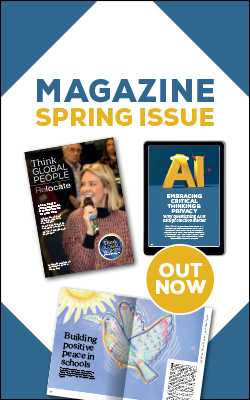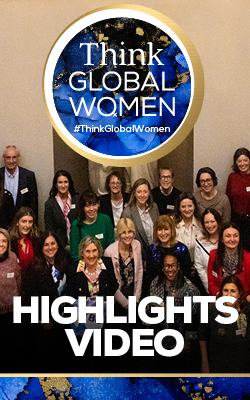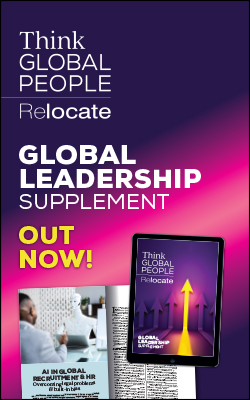The Next Normal: the business case for better mobility
The ‘New Normal’ is a chance to hone the ever-growing portfolio of mobility options and double down on strategic intent. Which practices and approaches offer the best return on investment – including upskilling mobility expertise? Ruth Holmes reports.

This article is taken from the Summer 2024 issue of
Think Global People magazine
Click on the cover to access the digital edition.
Evolving mobility
EY’s 2024 'Mobility Reimagined Survey' is one of a number newly released that offers a fascinating perspective on this pivotal moment for the role of cross-border moves in 2024 and beyond.Its analysis of the experiences of over 1,000 mobility professionals across 21 global geographies helpfully identifies five drivers of evolved mobility functions. It also quantifies the outcomes, finding that there are direct bottom-line benefits and greater organisational resilience where mobility is driven by:- Strategic alignment
- Talent linkage
- Digital focus
- Flexibility
- External expertise.
- Over twice as likely to say mobility helps organisational resilience and address talent shortages
- One and a half times more likely to say it helps address talent shortages
- 1.3 times more likely to offer positive return on investment (ROI).
Managing risky business
The scale of the challenge facing global businesses and mobility teams is obvious. Seven in ten (71%) EY survey respondents say cross-border mobility risks have increased in the last two years. Two-thirds (66%) are also expecting mobility’s scope to increase. Nearly all respondents (97%) are looking to manage costs more effectively. As telling is 95% of employers believe there are benefits to more closely aligning mobility to business and talent goals, but 60% still see mobility as isolated or siloed from other functions.While the EY study evaluates the financial benefits of aligning global people strategically through digital and external-expertise-enhanced frameworks, a new study by International SOS in partnership with KPMG highlights the cost of getting it wrong. It adds significant financial weight to the business case for emphasising the global people agenda at board level.According to the report, the cost of a failed international assignment can range from USD $850,000 to $1.25 million in higher tax jurisdictions, such as Canada, the UK, Denmark, France, Belgium, and Germany – also the most common destinations. These costs include compensation, relocation costs, ongoing assignment support and taxes. However, they do not cover the lost opportunity costs and the potential cost of employee attrition, or the often-intense wellbeing impact on the employee and any family members.Managing mobility and cross-border moves more purposefully can help mitigate these risks throughout the lifecycle. It’s become a question now of not ‘if’, but ‘how and when’, says Gerard Osei-Bonsu, highlighting the need for a much more integrated approach to cross-border moves.“Mobility teams can no longer stand on an island. For a long time there has been a lot of talk about how do we integrate mobility into the wider talent and or business agenda of organisations. That pivot is here. Just being able to move someone from A to B and doing all the transactional activities linked to that is not enough.“Organisations don’t want that. They are looking for someone who can business partner with them effectively, advise them on mobility strategies, identify who is the right person and what’s the right type of move and how to get proper ROI from this transfer. This is where mobility functions need to step up and be able to advise and engage with their businesses. That’s a big pivot from what they’ve done historically.”Expanding the mobility function for global people
In the New Normal, global mobility is increasingly about the ability of the function and sector to change, develop and step into this strategic advisor role, or recruit people with different profiles who can deliver as a business partner. Over the past year, the number of employers regarding mobility as critical for business resilience has increased from 74% to 89%.“There’s definitely a learning piece here about being far more strategic than transactional in nature,” agrees Gerard Osei-Bonsu. “Quite often, when I have this conversation with mobility leads, they say, ‘I hear you, Gerard, but we don’t have the time to do both. I don’t have time to manage moves and sit down with the business to work out what talent needs there are in three-five years’ time. I don’t have the resource or the capacity.’”The reality is that businesses also don’t have the luxury of standing still and not evolving their approach to global people and cross-border moves, as the International SOS figures show. Fortunately, “we are seeing a definite shift in the more evolved, progressive mobility approach programmes where the mobility function tag is almost falling away,” observes Gerard Osei-Bonsu. “It’s all generally being managed within the talent function. This is a particular specialism, but it is embedded into a talent and career framework of organisations, and not viewed as a separate transactional function. I think that particular trend needs to rapidly increase.”For Gerard Osei-Bonsu, the data show the value to the business of intentionally creating the capacity to deal with the reality of the New Normal. “It means being more selective and maybe smarter about what they handle internally within their function versus maybe what they deliver through their own shared-service function and external providers. It’s about really starting to move out the transactional aspects to create more time to sit down and speak with the business.”Five actions to evolve mobility and support global people
EY’s 2024 'Mobility Reimagined Survey' sets out five steps businesses can take to maximise the impact of global mobility on employee experiences, organisational resilience and agility.- Act strategically
- Embed and align mobility into the wider organisational strategy.
- Reduce operational silos and improve data exchange across business functions to increase mobility’s effectiveness.
- Integrate with talent
- Embed mobility into the wider workforce agenda, recognising its importance to developing future leaders.
- Enhance the mobility experience.
- Focus on digital
- Promote the use of new digital tools and ensure humans are at the centre of transformation.
- Prepare for GenAI to become widely adopted, with the potential to transform ways of working and mobile employee experience.
- Build people-first mobility programmes
- Build in flexibility to mobility programmes to enhance employee experience.
- Create a people mobility strategy that enables compliant hybrid and remote work.
- Put sustainable and inclusive thinking at the heart of mobility programmes.
- Develop resilient operating models
- Proactively address the rising risks caused by the changing mix of work models and international regulation.
- Leverage external providers to access know-how and take the pressure off in-house resources.
Read about award-winning global mobility, leadership and education in the upcoming Summer issue of Think Global People magazine, with the teams and organisations being celebrated in the Relocate Think Global People Awards 2024. Secure your copy here.

Have you heard about our Think Global People community?

Find out more about the Think Global People and Think Women community and events.

Subscribe to Relocate Extra, our monthly newsletter, to get all the latest international assignments and global mobility news.Relocate’s new Global Mobility Toolkit provides free information, practical advice and support for HR, global mobility managers and global teams operating overseas.
©2025 Re:locate magazine, published by Profile Locations, Spray Hill, Hastings Road, Lamberhurst, Kent TN3 8JB. All rights reserved. This publication (or any part thereof) may not be reproduced in any form without the prior written permission of Profile Locations. Profile Locations accepts no liability for the accuracy of the contents or any opinions expressed herein.





































